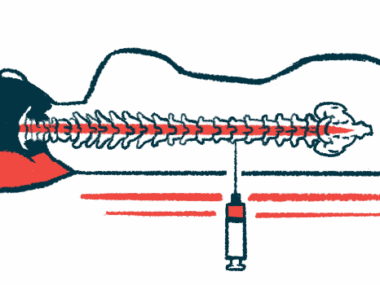Spinraza boosts upper arm, shoulder function in adults with SMA: Study
Strength tests could be used to identify patients not responding to Spinraza
Written by |

Adults with spinal muscular atrophy (SMA) who start treatment with Spinraza (nusinersen) tend to see the most dramatic early improvement in muscle strength in the shoulders and upper arms, a new study suggests.
The treatment also tended to improve thumb strength, which researchers note may be important for patients needing to steer a power wheelchair.
Based on these findings, scientists suggest that measuring upper arm and shoulder strength could help identify patients who aren’t responding to Spinraza so that alternative treatments can be tried.
The study, “Improvement of muscle strength in specific muscular regions in nusinersen-treated adult patients with 5q-spinal muscular atrophy,” was published in Scientific Reports.
Approval of Spinraza based on data from clinical trials in children
Spinraza was the first therapy to be approved for SMA; it works by boosting production of the SMN protein whose defect causes the disease. Approvals of Spinraza were based off of clinical trials that tested the therapy in children, but the therapy is available for patients of all ages, and data have suggested it can offer benefits to adults with SMA.
Although prior research has broadly suggested Spinraza can improve muscle strength for adults with SMA, there hasn’t been much research into whether these benefits tend to affect certain muscles more than others. Scientists at Hannover Medical School in Germany conducted a study to learn more.
“By looking at sum scores only, an improvement of specific muscles or function of clinical relevance might be missed,” they wrote.
“From patients’ and caregivers’ perspectives, minor improvements or even disease stabilisation are desirable and relevant for their individual quality of life and well-being,” they added. “Especially in non-ambulatory patients small movements can have major impacts on quality of life.”
The study included 15 adults with SMA who were starting on Spinraza. These patients ranged in age from 19 to 64; five of them had SMA type 2, nine had type 3, and one had type 4. Eight were able to walk, and the other seven were not (non-ambulatory).
Proximal upper limb and shoulder girdle muscles were earliest and most prominently improved by [Spinraza], even in more advanced disease stages.
Strength of 71 muscles tested
Prior to the patients starting treatment, and then at regular intervals afterward, the researchers conducted evaluations testing the strength of 71 individual muscles — 21 in each leg and 14 in each arm, plus several around the neck and head. Muscle strength was measured using a standardized tool called the Medical Research Council score, then expressed as a percentage, with 100% representing normal strength and 0% representing no strength.
Before treatment, the average strength score for individual muscles ranged from 2% to over 95%. Proximal muscles — those closer to the body, in the shoulders and hips — were generally weaker than distal muscles (in the hands/feet), which is a well-established pattern that usually occurs in people with SMA. Patients generally had the least strength in their legs and hips, with somewhat more strength in their arms. Most had normal strength for muscles around the neck and head.
After 14 months on Spinraza, the patients’ overall strength scores (basically an average of all tested muscles) showed clinically meaningful improvements for six patients and decreased for three.
For specific muscle groups, the greatest improvements in strength were generally seen in upper arm and shoulder muscles, particularly with arm abduction (the ability to lift the arms away from the torso) and the ability to turn at the shoulder and extend the elbows. Wrist and thumb strength also tended to improve, though strength in fingers and toes generally declined.
“Proximal upper limb and shoulder girdle muscles were earliest and most prominently improved by [Spinraza], even in more advanced disease stages,” the researchers wrote. They noted that improvements in the strength of specific muscles were seen even among the few patients who had a decline in overall strength scores.
Muscle strength scores generally improved with Spinraza
The scientists also reported on muscle strength scores for seven patients who were followed for up to about two years starting a few months after they had begun treatment with Spinraza. Among these patients, muscle strength scores generally improved with treatment, particularly for proximal muscles in the shoulders and hips.
The team noted that this analysis is limited by the small number of patients. They also acknowledged that doing these detailed muscle tests can be tiring for patients, which may have led to variability in the results. Still, they said these data suggest that measuring shoulder and upper arm strength may be a good way to identify patients who are not responding to Spinraza.
“With an alternative therapy now available, treatment non-responders need to be recognized as early as possible to prevent further motor neuron degeneration and to treat every patient with the individually best suitable drug,” they wrote.
Spinraza is sold by Biogen, which was not involved with this study.








